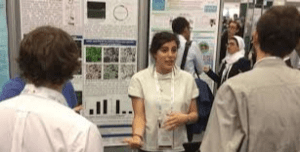A guest blog post by RoosterBio Travel Award winner, Gisele Calderon.
 The World Biomaterials Congress (WBC) takes place every four years with an energy rivaling the Olympics. This Congress is the largest gathering of biomaterials-focused researchers with over 1,200 oral presentations and 2,400 poster presentations representing over 60 countries. I am incredibly grateful to have been given the opportunity to present my work to and learn from the World’s finest leaders of the field.
The World Biomaterials Congress (WBC) takes place every four years with an energy rivaling the Olympics. This Congress is the largest gathering of biomaterials-focused researchers with over 1,200 oral presentations and 2,400 poster presentations representing over 60 countries. I am incredibly grateful to have been given the opportunity to present my work to and learn from the World’s finest leaders of the field.
Our work in the Miller Lab at Rice University focuses on vascularizing engineered tissues to address the metabolic needs of these complex tissues via various techniques. I develop a system to monitor cellular morphogenesis toward a stable capillary plexus allowing biology to dictate the architectural hierarchy. The cell-cell interactions between the endothelial cells derived from an iPS source and human mesenchymal stem cells tend to enhance the stability of the putative capillaries we form. Our novel multicolor genetic reporter system is enabling a new class of longitudinal studies of tubulogenesis and their integration with 3D printed vasculature.
3D Tissue Printing
- Dr. Jennifer Lewis, Lewis lab, Wyss Institute, Harvard University
- How can we directly print human tissue? Their approach utilizes top-down bioprinting elegantly recreating complex vascular geometries.
- A recent publication features RoosterBio’s hMSCs!
3D Printing complex scaffolds using Freeform Reversible Embedding of Suspended Hydrogels (FRESH)
- Dr. Adam Feinberg, Regenerative Biomaterials & Therapeutics Group, Carnegie Mellon University
- They 3DP crazy complex structures in a gel within gel fashion for ubiquitous support in their soft constructs. A fun note – he was inspired by Salvador Dali’s painting where everything droops down without support!
- Here’s their FRESH printing paper.
Hydrogels with continuously variable stiffness defined by dual-color micro-stereolithography
- Dr. Neils B Larsen, PolyCell group, Technical University of Denmark
- This group constructs 3DP soft constructs using stereolithography techniques in order to incorporate microvessels in their hydrogels. They are able to achieve consistent channels under 200um with tunable elasticity dependent on wavelength and exposure tie of incident light.
- More details can be found here.
